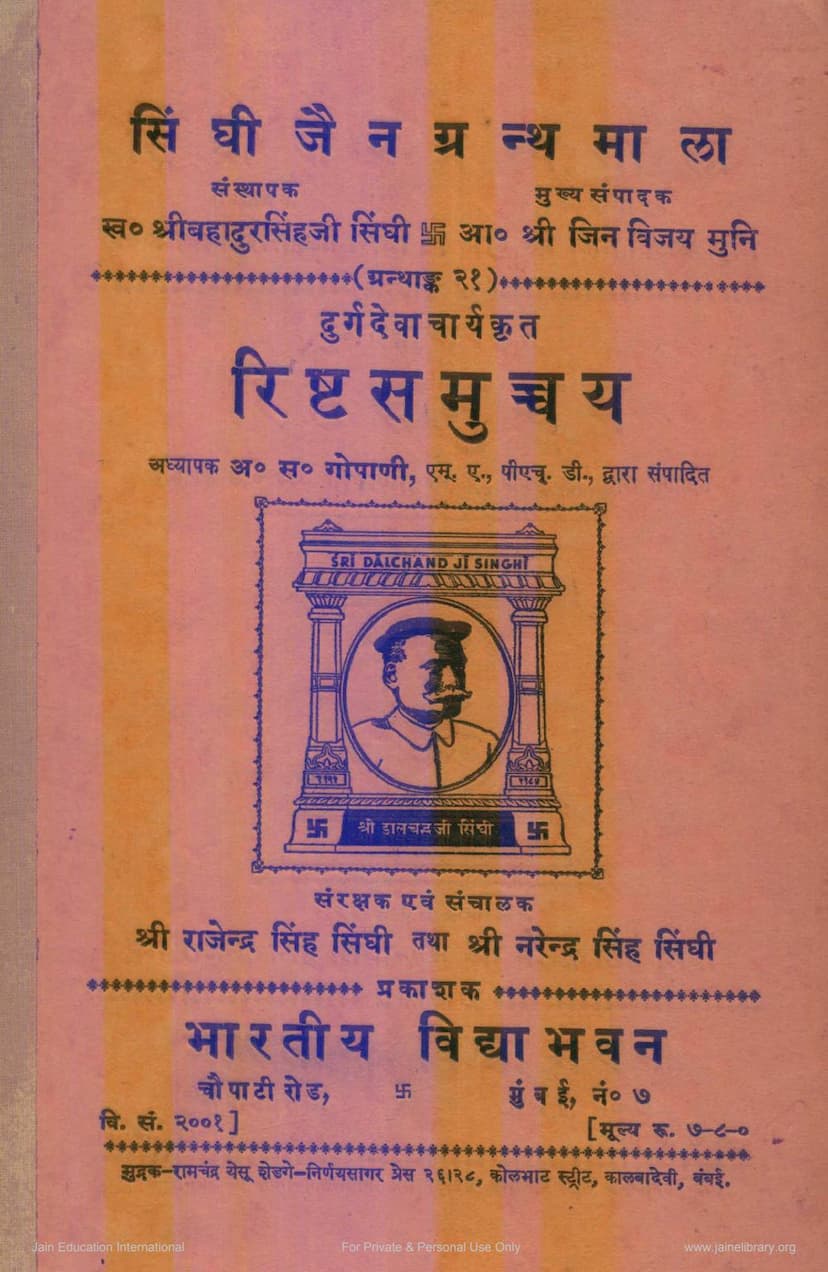Risht Samucchaya
Added to library: September 2, 2025

Summary
The book "Risht Samucchaya" by Durgadevacharya, edited by A. S. Gopani and published by Bharatiya Vidya Bhavan, is a critical edition of a significant Jain text focused on Riṣṭas (omens and portents of impending death). The series it belongs to, the Singhi Jain Series, is dedicated to publishing important Jain canonical, philosophical, historical, literary, and narrative works in Prakrit, Sanskrit, Apabhramsa, and Old Rajasthani-Gujarati languages.
Here's a comprehensive summary of the text and its accompanying scholarly material:
Title: Riṣṭasamuccaya (A Collection of Omens and Portents)
Author: Durgadeva (a Digambara Jain author of the first half of the 11th century A.D.)
Editor: Dr. A. S. Gopani, M.A., Ph.D. (Professor, Singhi Jain Śāstra Śikṣāpīth, Bhāratiya Vidya Bhavan)
Foreword: Prof. H. D. Velankar, M.A.
Publisher: Bharatiya Vidya Bhavan, Bombay
Publication Year: Vikram Samvat 2001 (1945 A.D.)
Key Aspects of the Book:
-
The Textual Material: The critical edition is based on three manuscripts (B, P, and S), which belong to different textual families. The editor notes the challenges in establishing the text due to variations, illegible portions, and scribal errors. Manuscript P shows a strong influence of Jaina Māhārāṣṭrī Prakrit, while B and S lean towards Jaina Saurasenī Prakrit, which is considered the original language of the work.
-
Durgadeva and His Works:
- Durgadeva: He is identified as a Digambara Jain scholar. He was a pupil of Samyamadeva, who was himself a pupil of Samyamasena, whose guru was Madhavacandra.
- Other Works: Besides the Riṣṭasamuccaya, Durgadeva is known to have authored the Arghakāṇḍa (a Prakrit work on the rise and fall of commodity prices) and the Mantramahodadhi (its nature is unknown due to lack of access, but it's believed to be in Prakrit).
- Place and Date of Composition: The Riṣṭasamuccaya was completed in Kumbhanagaranaga (identified with modern Kumher or Kumbher near Bharatpur) in the year 1089 (Vikrama Samvat) on the eleventh day of the bright half of Śrāvaņa, under the reign of King Lakṣmīnivāsa.
-
The Riṣṭasamuccaya - A Critical Study:
- Content: The Riṣṭasamuccaya is a concise work (261 stanzas) in Jaina Saurasenī Prakrit, dealing with various omens and portents that indicate impending death. Durgadeva is praised for his ability to condense a vast topic into a short compass.
- Classification of Riṣṭas: Durgadeva broadly categorizes Riṣṭas into three groups:
- Piṇḍastha: Related to physical signs on one's own body (e.g., cracking fingers, unresponsiveness of eyes, loss of taste, falling tears, inability to see one's own tongue).
- Padāstha: Related to external phenomena (e.g., seeing the moon and sun in various forms, feeling a burning lamp cold, appearance of the moon with or without curves and deer signs).
- Rūpastha: Related to form, further divided into Niyacchāyā (own shadow), Paracchāyā (other's shadow), and Chāyāpuruṣa (shadow-man).
- Dreams: The text extensively discusses dreams, classifying them into Devadakāhita (divine) and Sahaja (natural). It provides interpretations for various dreams and the timeframes within which they are believed to manifest.
- Pañha Riṭṭha: This section, dealing with questions, is the most extensive (95 stanzas), enumerating eight types: Angulipanha, Alattapanha, Gorocanapanha, Panhākṣara, Śakuna, Sahajasadda, Aksharapanha, Horāpanha, and Laggapanha.
- Originality: Durgadeva is noted for his original observations and sometimes diverging from established theories, suggesting he represented a distinct tradition. He is seen as an iconoclastic chronicler rather than a mere compiler.
- Dialect: The dialect is predominantly Jaina Saurasenī Prakrit, with influences from Ardhamāgadhi and Apabhramśa. The editor provides a detailed linguistic analysis.
- Metre: The primary metre used is the Gāhā, a common metre in Prakrit literature.
- Comparative Study: The Riṣṭasamuccaya is compared with various Vedic, Buddhist, and Jain texts (AV, AA, ON, MBh, VP, MatP, YS, MP, KS, CS, SS, VS, KJ, DS, SRS', UBPK). The study highlights both similarities and significant differences, suggesting the Riṣṭasamuccaya represents a unique tradition, possibly rooted in Digambara Jain thought, distinct from the more commonly found Svetambara traditions reflected in some other texts.
-
Maranaṇḍikā: The Riṣṭasamuccaya is based on an earlier work called the Maranakandikā. The editor notes the significant overlap between the two texts, with the Riṣṭasamuccaya appearing to be an expanded version.
-
General Discussion on Riṣṭas:
- Origin and Development: The concept of Riṣṭas is traced back to Vedic times and the Drstivada in Jainism. It evolved through various texts, with significant development seen in medical works and later Jain literature.
- Individual vs. General Riṣṭas: Riṣṭas are categorized into individual (affecting a single person) and general (foretelling national calamities). The book notes the interdependence of these categories.
- Riṣṭas in Non-Indian Literatures: The introduction includes a section on omens and portents in Greek, Roman, and early Christian cultures, highlighting common themes of fear, mysticism, and the interpretation of natural phenomena as divine signs.
- Riṣṭas in Vedic Literature: References to divination through sacrificial fire, victims, birds, beasts, and dreams are discussed, showing the ancient roots of this practice in India.
-
The Singhi Jain Series: The publication is part of a larger series established in memory of Babu Shri Dalchandji Singhi by his son Babu Bahadur Singhji Singhi. The series aims to publish scholarly editions of Jain texts and research works. The preface by the General Editor, Jinavijaya Muni, and the preface by Babu Bahadur Singhji Singhi highlight the philanthropic and scholarly efforts behind this series, noting the significant contributions of the Singhi family to Jain learning and culture.
Overall Significance:
The Riṣṭasamuccaya, as presented in this critical edition, is valuable for its:
- Comprehensive coverage of the science of omens and portents related to death.
- Detailed classification and interpretation of various Riṣṭas.
- Insight into the linguistic features of Jaina Saurasenī Prakrit.
- Contribution to understanding the diverse traditions within Jainism regarding divination.
- Scholarly apparatus, including an exhaustive introduction, English translation, notes, appendices, and indices.
The work is a testament to Durgadeva's mastery of these subjects and Dr. Gopani's meticulous editorial work, supported by the generous patronage of the Singhi family and the Bharatiya Vidya Bhavan.